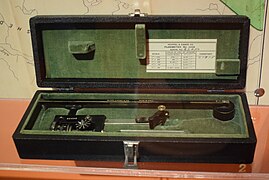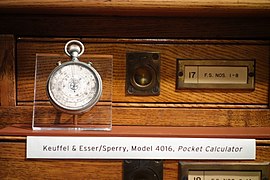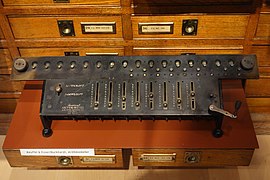
A slide rule is a hand-operated mechanical calculator consisting of slidable rulers for evaluating mathematical operations such as multiplication, division, exponents, roots, logarithms, and trigonometry. It is one of the simplest analog computers.
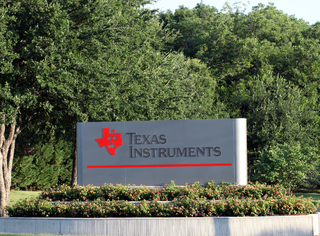
Texas Instruments Incorporated (TI) is an American information technology company headquartered in Dallas, Texas that designs and manufactures semiconductors and various integrated circuits. It is one of the top 10 semiconductor companies worldwide based on sales volume. The company's focus is on developing analog chips and embedded processors, which account for more than 80% of its revenue. TI also produces TI digital light processing technology and education technology products including calculators, microcontrollers, and multi-core processors. The company holds 45,000 patents worldwide as of 2016.
Celluloids are a class of materials produced by mixing nitrocellulose and camphor, often with added dyes and other agents. Once much more common for its use as photographic film before the advent of safer methods, celluloid's common contemporary uses are for manufacturing table tennis balls, musical instruments, combs, office equipment, fountain pen bodies, and guitar picks.
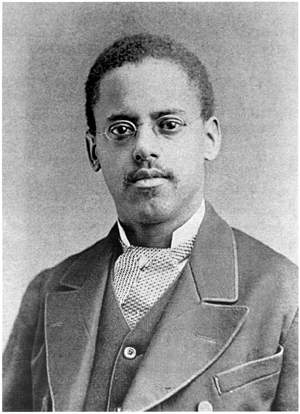
Lewis Howard Latimer was an American inventor and patent draftsman. His inventions included an evaporative air conditioner, an improved process for manufacturing carbon filaments for light bulbs, and an improved toilet system for railroad cars. In 1884, he joined the Edison Electric Light Company where he worked as a draftsman.

The Curta is a hand-held mechanical calculator designed by Curt Herzstark. It is known for its extremely compact design: a small cylinder that fits in the palm of the hand. It was affectionately known as the "pepper grinder" or "peppermill" due to its shape and means of operation; its superficial resemblance to a certain type of hand grenade also earned it the nickname "math grenade".
Micro Instrumentation and Telemetry Systems (MITS) was an American electronics company founded in Albuquerque, New Mexico that began manufacturing electronic calculators in 1971 and personal computers in 1975.

Olivetti S.p.A. is an Italian manufacturer of computers, tablets, smartphones, printers and other such business products as calculators and fax machines.
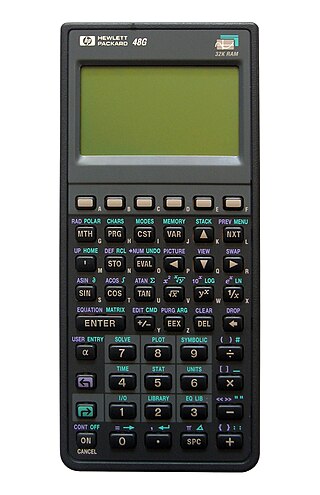
HP calculators are various calculators manufactured by the Hewlett-Packard company over the years.
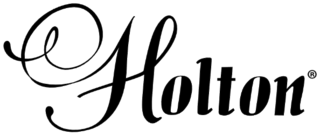
Holton is a brand owned by the Conn-Selmer division of Steinway Musical Instruments. The original business was a used instrument shop began in 1898 by American trombone player Frank Holton in Chicago, Illinois. The firm built brass instruments for ten years in Chicago, then in Elkhorn, Wisconsin from 1918 until 2008, when production of Holton-branded instruments moved to Eastlake, Ohio. The business remained independent until it was acquired by Leblanc in 1964. Leblanc was acquired by Conn-Selmer in 2004 and its properties became subsidiaries of Conn-Selmer.
Otis Carter Formby King (1876–1944) was an electrical engineer in London who invented and produced a cylindrical slide rule with helical scales, primarily for business uses initially. The product was named Otis King's Patent Calculator, and was manufactured and sold by Carbic Ltd. in London from about 1922 to about 1972.
The MIT Museum, founded in 1971, is located at the Massachusetts Institute of Technology in Cambridge, Massachusetts. It hosts collections of holography, technology-related artworks, artificial intelligence, architecture, robotics, maritime history, and the history of MIT. Its holography collection of 1800 pieces is the largest in the world, though only a few selections from it are usually exhibited. As of 2023, works by the kinetic artist Arthur Ganson are the largest long-running displays. There is a regular program of temporary special exhibitions, often on the intersections of art and technology.

Eugene Dietzgen (1862–1929) was a German-American manufacturer of engineering supplies. He was also a writer and promoter of the ideas of his father, the socialist philosopher Joseph Dietzgen.

The Keuffel and Esser Manufacturing Complex is located in Hoboken, Hudson County, New Jersey, United States. The western concrete building with the four-sided clock tower was built in 1906 and opened in 1907, after the previous building was destroyed by a fire in 1905. Keuffel and Esser manufactured instruments for the architectural, engineering and drafting professions at the complex from 1907 to 1968.

The Fulton–Nassau Historic District is a federally designated historic area of New York City roughly bounded by Broadway and Park Row, Nassau, Dutch and William Streets, Ann and Spruce Streets, and Liberty Street, in lower Manhattan. It contains a mix of late 19th- and early 20th-century architectural styles. The historic district lies just south of City Hall Park and east of lower Broadway. It is a historic district listed on the National Register of Historic Places.
The history of school and office products brand Westcott dates back to 1872, when Henry Westcott, together with his two sons Charles and Frank Westcott, started manufacturing wooden furniture used by printers and trellis units in Seneca Falls, New York. The company expanded rapidly and became one of the largest manufacturers of desk and school rulers in the world. Throughout its history it remained in Westcott family hands until it was purchased by Acme Shear Co. in 1968, which later changed its name to Acme United Corporation.

William James Young (1800–1870), probably born in Philadelphia, was indentured as an apprentice to instrument maker Thomas Whitney of Philadelphia for seven years beginning in 1813. Young was first listed in the 1825 Philadelphia directory as a mathematical instrument maker. He continued in business by himself until 1867 when Thomas N. Watson and Charles S. Heller joined him and the firm became known as William J. Young & Co. Young's son Alfred later took over the company and it became known as Young & Sons. It produced surveying and other precision devices until Keuffel and Esser of New York City acquired the company in 1918. Even then, K&E continued to offer a separate line of instruments with the Young & Sons name so as to maintain the customer base that had been built over the years. K&E moved the Young operation to Hoboken, New Jersey, in 1922.
Nelson Magor Cooke was a leader in developing electronic schools of the United States Navy, the recipient of the Navy Commendation Medal and Medal for Humane Action, a post-war engineering entrepreneur, and an author of books on applied mathematics and basic electronics.

Fowler Calculators Ltd was a manufacturer of slide rules and other scientific and mathematical instruments, based in Manchester, England and founded by William Henry Fowler.
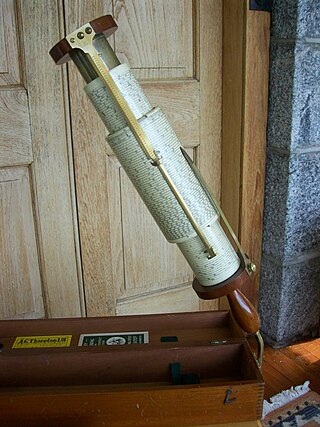
The Fuller calculator, sometimes called Fuller's cylindrical slide rule, is a cylindrical slide rule with a helical main scale taking 50 turns around the cylinder. This creates an instrument of considerable precision – it is equivalent to a traditional slide rule 25.40 metres long. It was invented in 1878 by George Fuller, professor of engineering at Queen's University Belfast, and despite its size and price it remained on the market for nearly a century because it outperformed nearly all other slide rules.

A slide rule scale is a line with graduated markings inscribed along the length of a slide rule used for mathematical calculations. The earliest such device had a single logarithmic scale for performing multiplication and division, but soon an improved technique was developed which involved two such scales sliding alongside each other. Later, multiple scales were provided with the most basic being logarithmic but with others graduated according to the mathematical function required.




